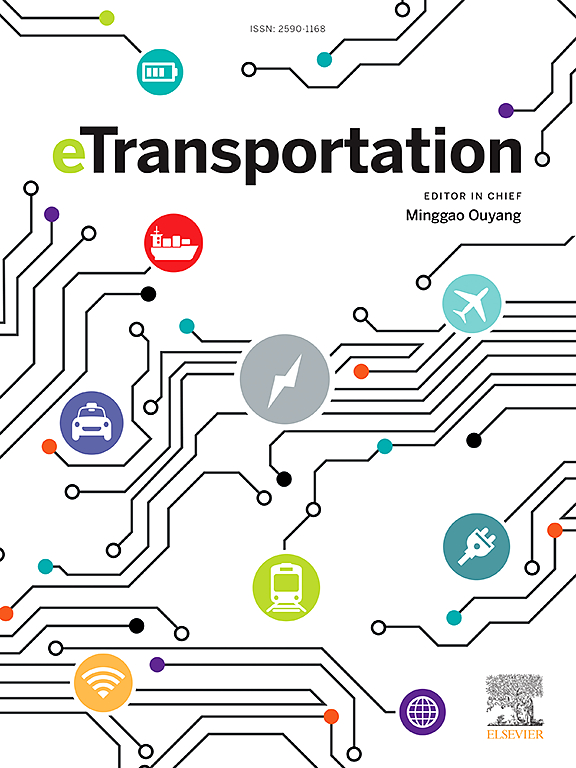Optimizing resilient parallel refueling operations: relaxed stochastic economic mobility scheduling for fuel cell vehicles with multiple hydrogen storage systems
IF 17
1区 工程技术
Q1 ENERGY & FUELS
引用次数: 0
Abstract
The growing demand for hydrogen-based mobility highlights the importance of management strategies for hydrogen refueling stations (HRSs), particularly in handling uncertainties related to hydrogen demand, energy forecasts, and market prices. This paper presents a sophisticated approach for managing an HRS powered by renewable energy sources (RESs) that addresses these uncertainties. The HRS is designed to support the simultaneous refueling of multiple hydrogen electric vehicles, including light vehicles and buses, and operates in both off-connected without access to the hydrogen market and on-connected with access to the hydrogen market. The connection to the hydrogen market allows for the purchase of hydrogen when RESs are insufficient and the sale of excess hydrogen. Additionally, a buffer-tank is integrated into the system to store surplus hydrogen, which can be converted to energy and sold to the electrical market when prices are favorable. The proposed strategy incorporates Boolean relaxations and a stochastic scenario-based approach within a model predictive control framework to enhance robustness against uncertainties and reduce computational complexity. Numerical simulations show that the strategy optimizes the use of multiple tanks for parallel refueling and ensures effective HRS operation by meeting hydrogen demands, satisfying operational constraints, minimizing costs, and maximizing profits. Furthermore, when compared to other strategies in the literature with a modeling and control perspective, incorporating degradation factors into control settings significantly reduces unnecessary electrolyzer switching, leading to a 30% decrease in operating expenses and over 2,000 fewer switching events annually, while the relaxed framework achieves nearly a 50% reduction in computation time with both open-source and commercial solvers (e.g., GUROBI).
优化弹性并行加氢操作:具有多个储氢系统的燃料电池汽车的宽松随机经济机动性调度
对氢动力汽车日益增长的需求凸显了加氢站管理策略的重要性,特别是在处理与氢需求、能源预测和市场价格相关的不确定性方面。本文提出了一种复杂的方法来管理由可再生能源(RESs)驱动的HRS,以解决这些不确定性。HRS旨在支持多种氢电动汽车(包括轻型汽车和公共汽车)同时加油,并且可以在没有进入氢市场的情况下和连接进入氢市场的情况下运行。与氢气市场的连接允许在RESs不足时购买氢气和出售多余的氢气。此外,系统中还集成了一个缓冲罐来储存多余的氢,这些氢可以转化为能源,在价格优惠时出售给电力市场。该策略在模型预测控制框架内结合了布尔松弛和基于随机场景的方法,以增强对不确定性的鲁棒性并降低计算复杂度。数值模拟结果表明,该策略优化了多罐并行加注的使用,并通过满足氢气需求、满足运行约束、成本最小化和利润最大化来保证HRS的有效运行。此外,与文献中的其他策略相比,从建模和控制的角度来看,将退化因素纳入控制设置可显着减少不必要的电解槽切换,导致运营费用降低30%,每年减少2000多个切换事件,而宽松的框架在开源和商业求解器(例如,GUROBI)的计算时间减少了近50%。
本文章由计算机程序翻译,如有差异,请以英文原文为准。
求助全文
约1分钟内获得全文
求助全文
来源期刊

Etransportation
Engineering-Automotive Engineering
CiteScore
19.80
自引率
12.60%
发文量
57
审稿时长
39 days
期刊介绍:
eTransportation is a scholarly journal that aims to advance knowledge in the field of electric transportation. It focuses on all modes of transportation that utilize electricity as their primary source of energy, including electric vehicles, trains, ships, and aircraft. The journal covers all stages of research, development, and testing of new technologies, systems, and devices related to electrical transportation.
The journal welcomes the use of simulation and analysis tools at the system, transport, or device level. Its primary emphasis is on the study of the electrical and electronic aspects of transportation systems. However, it also considers research on mechanical parts or subsystems of vehicles if there is a clear interaction with electrical or electronic equipment.
Please note that this journal excludes other aspects such as sociological, political, regulatory, or environmental factors from its scope.
 求助内容:
求助内容: 应助结果提醒方式:
应助结果提醒方式:


